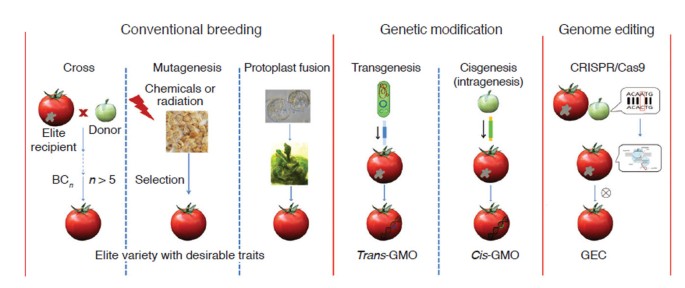CRISPR-Cas gene-editing tool has proven to be a powerful technology that can accurately and precisely alter the genomes of a plant. Gene editing can modify a plant’s genes without introducing any foreign genes. As a result of this technology, plant species for agriculture, food, and nutrition can be improved using a simple, precise and efficient method.
Many countries have adopted this technology to improve their crops and greatly benefit from it. For eg:
- The USDA has approved genome editing of mushrooms, soybeans, and petunia
- Japan approved CRISPR-edited nutritionally enhanced tomato

The examples above illustrate the progress being made in this field and encourage other countries, including India, to use CRISPR in plant breeding.
It would be a great help to Indian agriculture if these efficient gene editing tools could be adopted for precise editing, which would lead to developing crop varieties for climate resilience and nutritional security in timely manner. Now is the time for India to address greater issues such as climate adaptation of crops, dwindling natural resources, increasing input efficacy, and nutritional sufficiency for our citizens.
Many countries have not yet decided on the legal status of gene editing or are still discussing it. In India, for example, regulation of gene-editing is still under development. The South African government has begun negotiating gene editing regulations. Additionally, Burkina Faso, Nigeria, Ghana is now cultivating GM plants and Uganda is still debating the establishment of GMO legislation without explicitly mentioning genome editing. India has released a draft document in 2020 on Genome Edited Organisms in which it suggests a risk-based approach to regulating these products.
According to the guidelines, regulatory approval would be based on a tiered system of classification based on the type of genome editing.
- The plants in Group 1 contain a few or several base pair edits based on SDN-1 or ODM
- The plants in Group 2 contain a few or several base pair edits based on SD
In the draft, there is no clear distinction between a few and several. For Group 1 and Group 2, a risk assessment would include confirmation of the targeted edit, excluding biologically significant off-target effects, as well as a case-by-case comparison of the trait’s effectiveness with the reference varieties except for the edited trait. Group 3- plants with large DNA changes and foreign DNA insertions are in this group. If the plants are genetically modified, the same stringent risk assessment applies as in the case of traditional transgenic plants.
The regulatory framework must be deregulated and harmonised globally for gene-edited crops to be commercially viable. This will help the smallholder farmer and consumer.To realize the full potential of this technology, there must be regulatory impunity for such edited crop plants. If plants derived through gene editing are similar to their non-edited counterparts, it would be logical for them to be treated as conventionally bred plants. A number of countries around the world have implemented it, including the United States, Canada, Australia, Japan, and Argentina.
In terms of the seed industry, if the Indian government makes a similar decision, it will give smaller companies the opportunity to improve crops quickly and precisely using gene editing.
India must also align its agricultural policies with the major agricultural producing countries. The impact on seed trade, food production, safety, and security will be significant.
